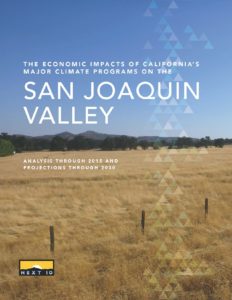The California Legislature may vote on reauthorizing California’s cap-and-trade program as soon as Monday. The program needs a two-thirds vote to inoculate the auction mechanism to distribute allowances from legal challenges, which is a heavy political lift that has required a lot of compromise and concession.
 But in the midst of the debate, state legislators are lacking crucial data on the impact of the program to date on some of California’s most environmentally and economically disadvantaged regions, particularly the San Joaquin Valley and Inland Empire.
But in the midst of the debate, state legislators are lacking crucial data on the impact of the program to date on some of California’s most environmentally and economically disadvantaged regions, particularly the San Joaquin Valley and Inland Empire.
To fill that gap, CLEE and the UC Berkeley Labor Center teamed up earlier this year to release a report on the economic impacts of California’s major climate programs on the San Joaquin Valley. And using the same methodology and publicly available data, we are soon to release a follow-up report on the Inland Empire, both sponsored by Next 10.
But with the vote looming on cap and trade, we wanted to release our findings on the impact of cap and trade on the Inland Empire in particular, as well as summarize our previous findings from the Valley report. Our new op-ed in yesterday’s Daily Bulletin summarizes the data:
After accounting for the costs and loss of jobs in industries required to comply with cap and trade, as well as the benefits from investments of cap-and-trade revenue, we found in the Inland Empire, the program had net economic impacts of $25.7 million, $900,000 in tax revenue and net employment growth of 154 jobs.
These net benefits do not account for funds that have been appropriated but have not yet been spent. Since only about one third of appropriated funds have so far been spent on projects in these regions, the positive impacts will only grow. When we account for the expected benefits after all funds collected are reinvested in projects, the net economic benefit reaches nearly $123 million, with 945 jobs created and $5.5 million in additional tax revenue.
We found even greater net positive impacts in the San Joaquin Valley, totaling $202 million in economic activity, along with $4.7 million in state and local tax revenue. The program also created 1,612 net jobs in the Valley. When including expected benefits after all funds collected are reinvested in projects, this figure balloons to nearly $1.5 billion in economic benefits. These projects will create 7,400 total jobs, including more than 3,000 direct jobs in the San Joaquin Valley.
We hope this information will be useful to the public and to legislators as they decide on the program’s fate beyond 2020. I will post again on the report once it’s available for release.


